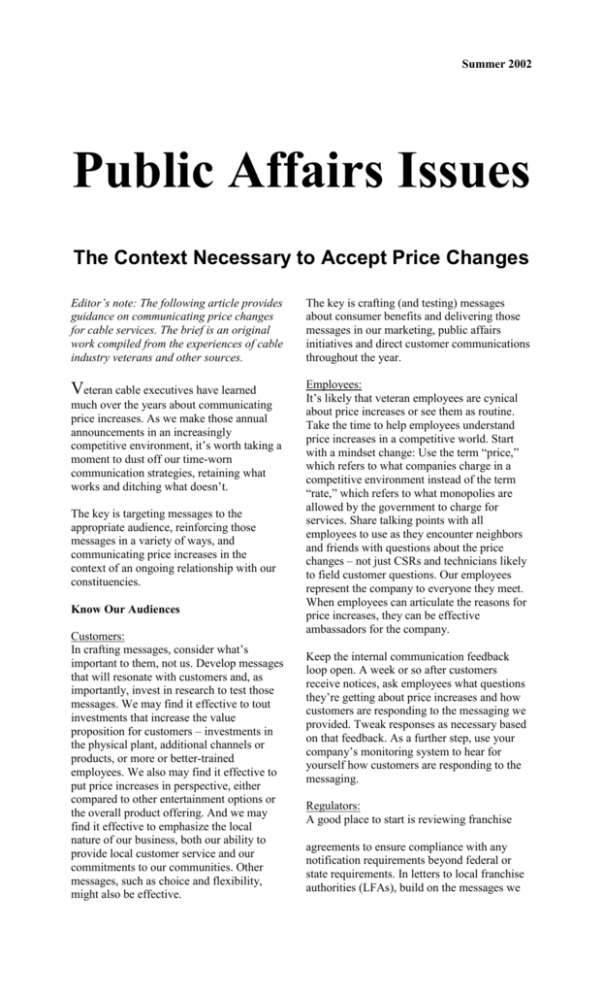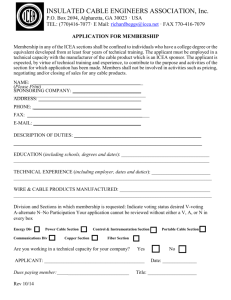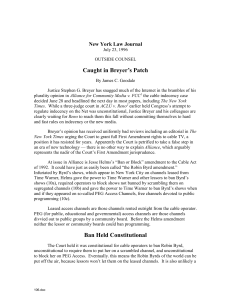Summer 2002 - Association of Cable Communicators
advertisement

Summer 2002 Public Affairs Issues The Context Necessary to Accept Price Changes Editor’s note: The following article provides guidance on communicating price changes for cable services. The brief is an original work compiled from the experiences of cable industry veterans and other sources. The key is crafting (and testing) messages about consumer benefits and delivering those messages in our marketing, public affairs initiatives and direct customer communications throughout the year. Veteran cable executives have learned Employees: It’s likely that veteran employees are cynical about price increases or see them as routine. Take the time to help employees understand price increases in a competitive world. Start with a mindset change: Use the term “price,” which refers to what companies charge in a competitive environment instead of the term “rate,” which refers to what monopolies are allowed by the government to charge for services. Share talking points with all employees to use as they encounter neighbors and friends with questions about the price changes – not just CSRs and technicians likely to field customer questions. Our employees represent the company to everyone they meet. When employees can articulate the reasons for price increases, they can be effective ambassadors for the company. much over the years about communicating price increases. As we make those annual announcements in an increasingly competitive environment, it’s worth taking a moment to dust off our time-worn communication strategies, retaining what works and ditching what doesn’t. The key is targeting messages to the appropriate audience, reinforcing those messages in a variety of ways, and communicating price increases in the context of an ongoing relationship with our constituencies. Know Our Audiences Customers: In crafting messages, consider what’s important to them, not us. Develop messages that will resonate with customers and, as importantly, invest in research to test those messages. We may find it effective to tout investments that increase the value proposition for customers – investments in the physical plant, additional channels or products, or more or better-trained employees. We also may find it effective to put price increases in perspective, either compared to other entertainment options or the overall product offering. And we may find it effective to emphasize the local nature of our business, both our ability to provide local customer service and our commitments to our communities. Other messages, such as choice and flexibility, might also be effective. Keep the internal communication feedback loop open. A week or so after customers receive notices, ask employees what questions they’re getting about price increases and how customers are responding to the messaging we provided. Tweak responses as necessary based on that feedback. As a further step, use your company’s monitoring system to hear for yourself how customers are responding to the messaging. Regulators: A good place to start is reviewing franchise agreements to ensure compliance with any notification requirements beyond federal or state requirements. In letters to local franchise authorities (LFAs), build on the messages we use with consumers, perhaps with additional emphasis on local investments or greater detail in explanations for increases. If the LFA is regulating Basic Service Tier and equipment rates, take time to meet with officials one-on-one prior to notifying customers. Remind them that increases are in compliance with the law, don’t assume that city staff or elected officials understand how prices are (and aren’t!) regulated, and be prepared to explain the process. Give city staffers direct access to someone at the cable company to whom they can refer questions and concerns from constituents. Media: Some operators still send out a press release about price changes; others have determined that there’s no reason to proactively announce price changes to the media. Operators who opt not to announce an increase to the media still should be prepared for media calls after customer notices go out. Many have had success pitching the reporter on doing a comparative story about competitive products or a story that highlights the new channels or new products being added. Reporters who have covered the industry a while may just be in the habit of portraying cable as a monopolistic utility whose rates are set in a vacuum; help them break that habit. If they insist on writing a story, we may be better off with one that puts prices in perspective than a story that reports a price increase in isolation. It’s All About Relationships Underscoring all of the above advice, however, is that it’s all about relationships. Price-increase time is not the time to introduce ourselves to our customers, regulators and media. If we are reaching out to these constituencies year-round to build a positive image, they can view price changes as we do: just one element of our company and our business strategy. Cable operators are technology leaders. We provide products and services that consumers are asking for, in an increasingly competitive environment. Cable operators are partners in their communities through their extensive outreach: educational initiatives, scholarships to local schools, Cable in the Classroom programs, donating free highspeed Internet service to schools and libraries, supporting local contests, sponsoring community non-profit organizations and events, and much more. Year-round, we must tell both stories – about our products and about our corporate citizenship – directly. We can and should work the media to get the word out in traditional PR placements. But we must use other avenues to tell our own story. Here are just a few of the most obvious (but underused) mechanisms: Seek press coverage of every major contribution or event sponsorship and arrange compelling photo ops surrounding them, ideally encouraging the recipient to directly solicit coverage. Send letters to local franchising authorities and elected officials about every new product launch and every major community sponsorship. Or, consider sending a quarterly newsletter designed specifically for regulators. Include elected officials in every event we host. Invite them to press conferences, have them cut ribbons on new product launches, put them at the top of every VIP invitation list. Use our own ad-avails to promote our community-outreach initiatives. Host media back-grounding sessions with individual reporters and editors so they can understand – at their convenience, not on deadline – how the cable business works and the role of the operator as an important community and corporate partner. Make sure they understand the fundamentals of how we’re regulated, the limited role of rate regulation, and how competition is benefiting our customers. Prepare regular bill-stuffers or customer newsletters about our products and our community commitments. Work with marketing to reinforce these value messages in cross-channel and other advertisements. Use our Web sites at every opportunity. Regularly post customer bill-insert newsletters, image marketing campaigns and community-involvement press releases. At price-increase time, post a letter to customers, emphasizing the key messages. Communication is an ongoing process. We must repeat messages over and over until they are heard and believed. By carefully crafting our messages, and then repeatedly delivering those messages to constituencies in a variety of ways, we provide our customers with the context necessary to accept price changes. © Copyright CTPAA 2002








